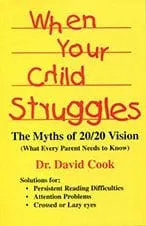What is Dyslexia?
What is Dyslexia?
The purpose of our Dyslexia and Vision Evaluation is to get to the heart of what is causing the reading problem.
Before vision therapy, Nathaniel spent two years in kindergarten without learning the entire alphabet or any sight words. Now he is learning to read and not only recognizes school words but reads all kinds of signs out in the world. His handwriting has improved, as well as his attitude in school.
Eight out of ten bright children practically teach themselves to read. It doesn’t matter which reading program is used, the child rapidly masters the reading skills. Dyslexia is a term used when a child does not respond to a standard reading program and needs to be guided one tiny step at a time. The term is a catch-all used to describe any condition that makes it difficult for a bright child to learn to read. Different children have different reasons or combinations of reasons for not learning to read. These are a few of the more common:
Language problems:
The child my not understand the meaning of the words or be familiar with language. If when you read to the child, he does not understand an age-appropriate story, a language problem is very likely tied to the reading problem. If a child easily understands when being read to, then the most serious obstacle to reading comprehension is probably not present.
Phonemic Awareness:
The child cannot hear a stream of sound and break it down into its parts. For instance, the child might not hear that the word doghouse is made up of the sounds dog and house. Or he child might not hear that the word coat is made up of the “k” sound and the word oat. Children who do not hear the sounds in words have difficulty with typical phonics programs because they cannot hear the sounds they are trying to match with the letters.
Automatic Naming:
The child is very slow at looking at a symbol, remembering what to call it, and getting the sound out. Poor automatic naming makes a child very slow at sounding out words. The better that child’s ability to recognize whole words, the quicker he will be able to read.
Visualization:
The child either cannot picture words in his mind or has not been taught to picture words. Thus, when the child sounds out a word in one line he does not recognize the same word in the next line. On the other hand, a child who pictures words easily may have a good sight vocabulary but still not be able to “sound out” words seen for the first time. When it comes to reading comprehension rather than decoding, the child who has not learned to picture the story being read is at a disadvantage.
Spatial Perception/Eye-Teaming:
The child is confused by symbols when they are crowded together. He can recognize a word with the letters well-spaced and large on a flashcard, but cannot recognize the same word when the letters are small and crowded together in a line of print. Such spatial perception problems can be due to print doubling and running together because of eye-teaming problems like convergence insufficiency. This confusion is also described on our Reading webpage.
Directionality:
The ability to understand the concepts of right and left in space. A young child has two directions: “toward me” and “away from me.” A b and d is a line with a half circle, and the circle goes “outward” or “away from me”. Such a child will not understand how a b is different than a d. This is a different problem than merely not remembering which letter is which. To such a child, the b and d look “the same.” The various “tricks” for teaching the difference between b’s and d’s may not work without first addressing the directionality problem.
It could be any or all of the above. Only a reading specialist is trained to work around the reasons children do not learn to read. If we eliminate the reasons themselves, however, there is far less to work around. Once a child can comfortably look at the parts of a word, picture the parts of a word in his mind, and hear the parts of the word, the learning rate should increase dramatically. This makes it relatively easy to go back to the beginning and fill in the missing reading skills. The review process remains necessary because our vision therapy programs do not teach missing phonics skills. The difference is that the review can now generally be done by a good tutor, a home educator, or a reading specialist because the child no longer has to sound out the same word in a line he sounded out in the previous line.
Check Out Our Resources
Dr. Cook’s Publications:
- Authored books VISUAL FITNESS and WHEN YOUR CHILD STRUGGLES.
- Published articles in top optometric journals.
- His article “Eyesight, infinity and the human heart” was voted “Best Non-Technical Article” by the Association of Optometric Editors.



